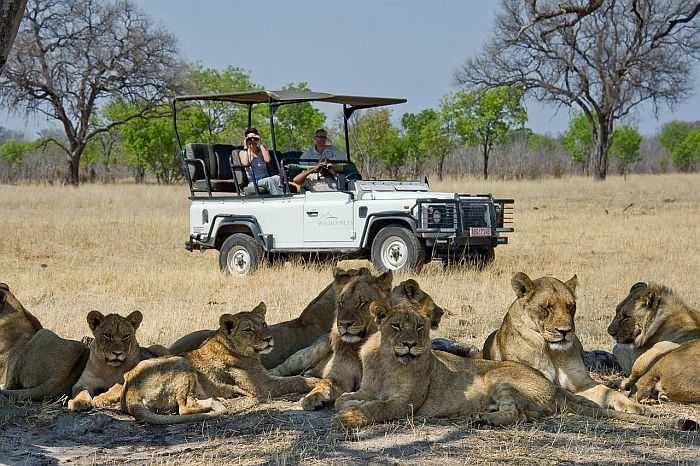A Hwange safari offers spectacular big game country only two hours drive south from Victoria Falls.
Hwange National Park is Zimbabwe’s largest and oldest game park ranging over an area of 14,600 km². Its sheer size means that it offers a range of vegetation with a resulting diversity of game. It ranges from the dry southern acacia bush bordering the Kalahari Desert to the mopane woodlands, valleys and granite hills characteristic of the north. Hwange is certainly big game country with massive herds of elephants. Which you'll see plentiful numbers, especially at the end of the dry season in September and October. These are joined by lion, buffalo, hyena, giraffe, zebra, wildebeest sable, roan and other antelope.
The shallow salt pans throughout the park actually make for easier Game-viewing in Hwange National Park. These natural salt pans offer the perfect cooling mud bath for elephants. And gradually the pans develop into small waterholes. However because of the deep Kalahari sands, these waterholes dry up as the dry season progresses. Hwange is unusual in that, right from the park’s inception, the rangers have pumped water into these waterholes in the dry season. So a Hwange safari between July to October offers plenty of wildlife as animals flock to these pans for much-needed water. A veritable mecca for game in the dry winter months!

We arrange trips to more than 100+ destinations throughout the African continent.
Situated on the boundary of Hwange National Park 2 hours from Victoria Falls and a few kilometers from Hwange park entrance. We stayed for 2 nights and were really impressed. Great personal experience for a very reasonable price. We stayed in a tree house that overlook a waterhole. They offer 3 good meals a day and all clients eat together at a large dining table. As a special treat they arranged the Ingonyama performing troupe after dinner on our last night and I was very impressed with their true and artistic impersonation of wild animals. It can be arranged at an additional cost during your stay.
We were privileged to meet Sharon Pincott, she works closely with the Presidential elephant herd on a daily basis. We did a game drive on Hwange Estate, home range of the presidential elephant herd, made famous internationally by Sharon Pincott who resides in a cottage at Miombo. Usually an Elephant drive to meet the Presidential herd will be done by the guides of Miombo and not by Sharon. On our drive with her we spotted a newly born baby elephant and as it was part of the “W” family we named her Whisper.
That afternoon close to Miombo we visited the Painted Dog Centre which is included in the fully inclusive rate. http://www.painteddog.org/ – Painted Dog Conservation (PDC) works to save the endangered African wild dog it is an African wild dog research project in Hwange NationalPark. A great option to get closer to the wild life inside the park is also to combine your stay at Miombo with a Mobile safari inside the Hwange Park (at an additional cost and need to be pre-arranged) I think I will opt for that in high season during the drier months between July and September on my next visit.
